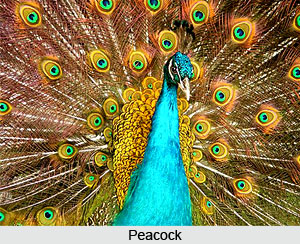 Peacock, also called Peafowl, is a hefty and vibrantly coloured bird belonging to the pheasant family and is also the national bird of India. The peacock flaunts a gleaming blue breast and neck and a spectacular bronze-green train of around 200 elongated feathers. It is capable of extending its tail erect like fan as ostentatious display. The male peacock is mostly known for the long train of elongated upper-tail covert feathers that resembles colourful eyespots. The train covers almost 60% of their total body length. Along with the large wingspan, this tail makes the peafowl one of the largest flying birds through out the world. These elongated feathers are raised quivered in a display during courtship. The female Peacock, consisting of a duller brown plumage, has a slightly greenish lower neck and lacks the train. The Indian Peacocks are mainly found in open forested areas where they scavenge for grains and berries, and also prey on lizards, snakes and small rodents.
Peacock, also called Peafowl, is a hefty and vibrantly coloured bird belonging to the pheasant family and is also the national bird of India. The peacock flaunts a gleaming blue breast and neck and a spectacular bronze-green train of around 200 elongated feathers. It is capable of extending its tail erect like fan as ostentatious display. The male peacock is mostly known for the long train of elongated upper-tail covert feathers that resembles colourful eyespots. The train covers almost 60% of their total body length. Along with the large wingspan, this tail makes the peafowl one of the largest flying birds through out the world. These elongated feathers are raised quivered in a display during courtship. The female Peacock, consisting of a duller brown plumage, has a slightly greenish lower neck and lacks the train. The Indian Peacocks are mainly found in open forested areas where they scavenge for grains and berries, and also prey on lizards, snakes and small rodents.
The loud calls of the Peacock generally indicate the arrival of predators like Tiger. They usually rummage on the ground, and are found in small groups. When in threat, Peacocks generally escape on foot and evade flying. But in order to rest, Peacocks do fly up to tall trees.
Features of Peacock
The male Peacock is attributed with a 7.3 ft length, in full breeding plumage, and weighs around 5 kg. The female bird, known as Peahen, is almost 95 cm long and weighs around 3.5 kg. The peacock has an extension of feathers on its back and a glistening blue-green plumage. Each feather is epitomised with an eye at the end. The Indian Peahen is an amalgamation of iridescent blue, dull green and grey and, with the greenish-grey colour. The adult Peahen has a rufous-brown head with a crest but the tips are chestnut edged with green. Other deviations of Peacocks are the white pied forms, which are the outcomes of allelic variation at specific loci.
Distribution of Peacock
Peacocks are primarily found in the Indian sub-continent, from the east to south of the Indus river. There also found in Punjab, south Mizoram, east Assam, Jammu and Kashmir and the entire Indian peninsula. These birds reside in forests near a source of water. Peacocks are found in the dry semi-desert grasslands, scrub and deciduous forests. They mainly feed on seeds, but also consume insects, reptiles and fruits. Their size, colour and shape of crest make them unmistakable within their native distribution range.
Ecology and Behaviour of Peacock
The flamboyant train is assumed to be the outcome of female sexual selection as males elevate their feathers and quiver them as an instinctive ritual of courtship display. The quality of train is a sincere indication of the condition of males and the peahens choose males on the basis of their plumage. The long train feathers of the male develop only after the 2nd year and full grown trains are found in birds they reach four years of age. Peacocks scavenge on the ground, in small groups that usually have 1 male and 5 female. After the breeding period, the group tends to comprise of only females and young.
Dietary Habits of Peacock
Indian Peacocks are omnivorous and eat insects, seeds, fruits, drupes, wild figs, small mammals like rodents, and reptiles. They also consume small sized snakes but avoid larger and venomous ones. In the Gir forest, Gujarat, their staple food is consists of the fallen berries of Zizyphus. In cultivated areas, peacock feed on a variety of crops like Paddy, Groundnut, Chilly, Tomato and Bananas. In regions inhabitated by human population, Peacocks consume food wastes and human excreta.
Religious Significance of Peacock
In Hinduism, the Peacock has a lot of significance as it is associated with many Hindu gods and deities. Known as Mayura in Sanskrit, the peacock is portrayed in several traditions, mythology, temple art, folk-music and poetry. Lord Krishna is usually illustrated with a feather in his headband, Goddess Saraswati, representing kindness and knowledge, is also seen with a peacock. Peacock is also seen on the mount of Lord Karthikeya, the God of war.
Peacock as a National Symbol
The Indian peacock is the National Bird of India, is widely found in the Indian sub-continent and is severely protected in all regions where the bird is found under the Indian Wildlife Protection Act, 1972.
Conservation of Peacock
The peacock has a close association with the human population and thus the bird has conveniently adapted to the human inhabited regions. They are legally and culturally protected in various parts of the country. However, illegal poaching of peacocks for meat and feathers has risen gradually in India. Moreover, pesticides in crops and seeds also pose threats to the national bird. Indian law has developed methods that allow the collection of feathers that have been shed naturally.
In captivity, Peacocks usually live for around 20-23 years, but in the wild, they live for only about 15 years, as per conservative estimations.



















